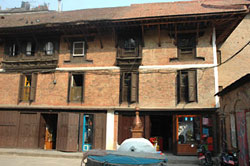

Anticipating the consequences of the loss of this invaluable resource, Patan Tourism Development Organization (PTDO) initiated a programme in 1997 to
identify and promote selected traditional houses within Patan Monument Zone and renovate these properties providing new sympathetic uses for them. The
Urban Development through Local Efforts project (UDLE / GTZ) extended its help in preparing existing and proposed plans of the three identified
buildings and also prepared the cost estimation. PTDO with the active support from the Department of Archaeology of His Majesty’s Government (HMG) of
Nepal and UNESCO experts proposed these projects to UNESCO for international funding. This proposal was also produced in the donors’ meeting held in
Kathmandu in 1996 that was jointly organised by UNESCO World Heritage Centre & HMG Department of Archaeology and chaired by Right Honourable Mr. Sher
Bahadur Deuba, the Prime Minister of Nepal.
In 1998 National Federation of UNESCO Associations in Japan (NFUAJ) showed interest in this project and agreed to fund two projects, namely the Shrestha
House and the Rajbhandari House.

1. THE SHRESTHA HOUSE
The Shrestha House is a well–preserved example of a traditional Newari house of Kathmandu valley. The house is located on the road between the Durbar
Square and the bridge across the Bagmati at Sankhamul Ghat, which is an ideal location for its intended new use. The property is built of brick and
timber in traditional Malla style with three wings around a courtyard, the narrowest wing of which had been well restored and converted to modern living
2. THE RAJBHANDARI HOUSE

The Rajbhandari House, which faces onto one of the smaller squares in the Patan Monument Zone, is an outstanding example of traditional town house of
the Malla period. The front and side wings embrace a large internal courtyard, which is partially closed on its fourth side by a separate building from
the Shah period. Behind this structure lies an attractive garden.
 Anticipating the consequences of the loss of this invaluable resource, Patan Tourism Development Organization (PTDO) initiated a programme in 1997 to
identify and promote selected traditional houses within Patan Monument Zone and renovate these properties providing new sympathetic uses for them. The
Urban Development through Local Efforts project (UDLE / GTZ) extended its help in preparing existing and proposed plans of the three identified
buildings and also prepared the cost estimation. PTDO with the active support from the Department of Archaeology of His Majesty’s Government (HMG) of
Nepal and UNESCO experts proposed these projects to UNESCO for international funding. This proposal was also produced in the donors’ meeting held in
Kathmandu in 1996 that was jointly organised by UNESCO World Heritage Centre & HMG Department of Archaeology and chaired by Right Honourable Mr. Sher
Bahadur Deuba, the Prime Minister of Nepal.
Anticipating the consequences of the loss of this invaluable resource, Patan Tourism Development Organization (PTDO) initiated a programme in 1997 to
identify and promote selected traditional houses within Patan Monument Zone and renovate these properties providing new sympathetic uses for them. The
Urban Development through Local Efforts project (UDLE / GTZ) extended its help in preparing existing and proposed plans of the three identified
buildings and also prepared the cost estimation. PTDO with the active support from the Department of Archaeology of His Majesty’s Government (HMG) of
Nepal and UNESCO experts proposed these projects to UNESCO for international funding. This proposal was also produced in the donors’ meeting held in
Kathmandu in 1996 that was jointly organised by UNESCO World Heritage Centre & HMG Department of Archaeology and chaired by Right Honourable Mr. Sher
Bahadur Deuba, the Prime Minister of Nepal.
